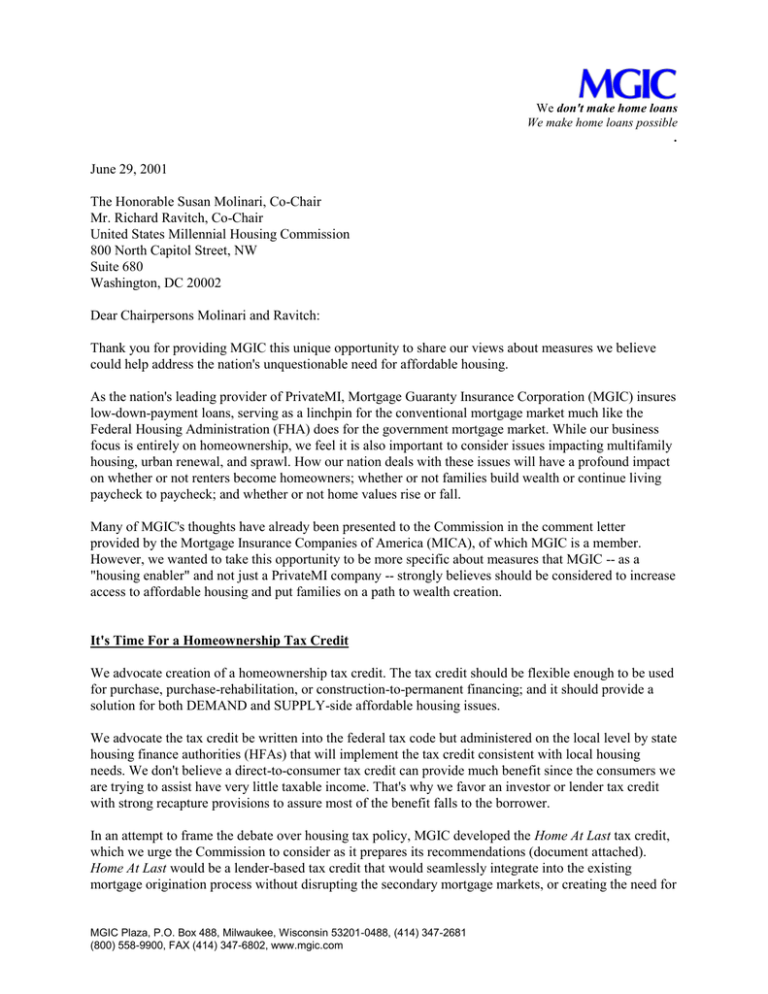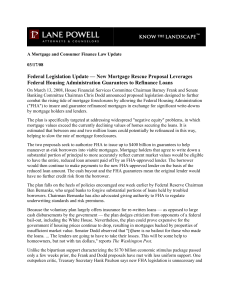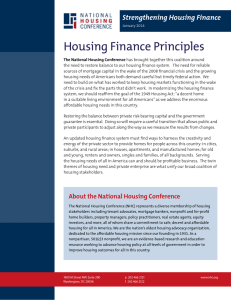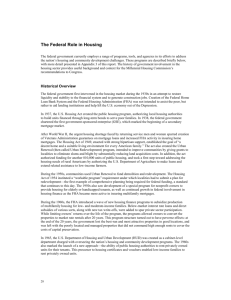Document 15585089
advertisement

We don't make home loans We make home loans possible . June 29, 2001 The Honorable Susan Molinari, Co-Chair Mr. Richard Ravitch, Co-Chair United States Millennial Housing Commission 800 North Capitol Street, NW Suite 680 Washington, DC 20002 Dear Chairpersons Molinari and Ravitch: Thank you for providing MGIC this unique opportunity to share our views about measures we believe could help address the nation's unquestionable need for affordable housing. As the nation's leading provider of PrivateMI, Mortgage Guaranty Insurance Corporation (MGIC) insures low-down-payment loans, serving as a linchpin for the conventional mortgage market much like the Federal Housing Administration (FHA) does for the government mortgage market. While our business focus is entirely on homeownership, we feel it is also important to consider issues impacting multifamily housing, urban renewal, and sprawl. How our nation deals with these issues will have a profound impact on whether or not renters become homeowners; whether or not families build wealth or continue living paycheck to paycheck; and whether or not home values rise or fall. Many of MGIC's thoughts have already been presented to the Commission in the comment letter provided by the Mortgage Insurance Companies of America (MICA), of which MGIC is a member. However, we wanted to take this opportunity to be more specific about measures that MGIC -- as a "housing enabler" and not just a PrivateMI company -- strongly believes should be considered to increase access to affordable housing and put families on a path to wealth creation. It's Time For a Homeownership Tax Credit We advocate creation of a homeownership tax credit. The tax credit should be flexible enough to be used for purchase, purchase-rehabilitation, or construction-to-permanent financing; and it should provide a solution for both DEMAND and SUPPLY-side affordable housing issues. We advocate the tax credit be written into the federal tax code but administered on the local level by state housing finance authorities (HFAs) that will implement the tax credit consistent with local housing needs. We don't believe a direct-to-consumer tax credit can provide much benefit since the consumers we are trying to assist have very little taxable income. That's why we favor an investor or lender tax credit with strong recapture provisions to assure most of the benefit falls to the borrower. In an attempt to frame the debate over housing tax policy, MGIC developed the Home At Last tax credit, which we urge the Commission to consider as it prepares its recommendations (document attached). Home At Last would be a lender-based tax credit that would seamlessly integrate into the existing mortgage origination process without disrupting the secondary mortgage markets, or creating the need for MGIC Plaza, P.O. Box 488, Milwaukee, Wisconsin 53201-0488, (414) 347-2681 (800) 558-9900, FAX (414) 347-6802, www.mgic.com 07/11/16 Page 2 a specialized secondary mortgage market. Home At Last represents the most flexible approach to creating affordability because it can be used with most types of mortgages (conventional, FHA, VA, etc.) and for home purchase, purchase-rehabilitation, or home construction-to-permanent financing. By applying the tax credits as points to buy down the first mortgage rate, Home At Last is able to achieve a bigger bang for the taxpayers' buck than direct cash subsidies while providing homebuyers the lowest possible monthly mortgage payment. MGIC has talked with a number of housing and mortgage lending trade groups and reaction to the Home At Last tax credit has been favorable. To that end, we are in the process of developing a working paper to show how the tax credit can be used to address both demand and supply issues related to affordable housing. Though we have gone to great lengths to develop and promote the Home At Last concept, we want to make it clear that MGIC supports maintaining the Mortgage Interest Deduction (MID) and also supports the Administration's American Dream Tax Credit. We're are not zealous about any one tax credit program; but we are zealous about the nation's need for a single-family tax credit that addresses both demand and supply issues. The time has come for a homeownership tax credit that targets families most in need and deserving of assistance. More Down Payment and Closing Cost Assistance is Needed We support increased allocations to federal programs ( like CDBG, HOME, etc.) which provide direct, lump-sum down payment and closing cost assistance to borrowers through local allocating agencies. This type of assistance helps borrowers who have the income to support a mortgage payment, but cannot save fast enough to buy a home and start building wealth through equity. Additionally, this type of assistance helps the private sector serve a larger population of borrowers. Policy Should Promote Pre- and Post-Purchase Borrower Support We believe strongly in the benefits of pre-purchase education and counseling provided before the home search begins, and post-purchase borrower support, including early delinquency intervention. Unfortunately, the organizations that provide these services must compete for a limited supply of corporate contributions or meager federal funds. We support passage of a law that would allow these non-profit agencies to recover the cost of providing these services (up to a dollar-amount set by law) through a lump-sum charge that would be financed as part of the loan amount. This will have a nominal effect on monthly payments charged of consumers and is, in our minds, a justifiable cost because the benefit to the consumer is homeownership. In addition, a subsidy will still be necessary to support nonprofit groups' infrastructure costs and costs associated with serving borrowers whom are unsuccessful in their attempts to attain homeownership. Turning the LIHTC into a Wealth-Building Tool 07/11/16 Page 3 Relative to the Low-Income Housing Tax Credit (LIHTC), we'd like to see it used for the construction of units which renters can ultimately own and build equity. While the most critical housing needs this country faces may well be in the multifamily sector, we feel it is sound public policy to promote homeownership because of its wealth-creating benefits. Specifically, we'd like to see lease-to-purchase and cooperative housing supported by the LIHTC. This would allow for the construction of affordable units that renters may ultimately own. The idea of expanding the LIHTC to lease-to-purchase and coop arrangements was originally forwarded in June 1998 in a Brookings Institute document titled Summary of Home Ownership Tax Credit Proposals. The LIHTC currently allows lease-to-purchase arrangements, but requires that buyers lease a home for 15 years before having the option to buy. This is too long. As a result, some groups have suggested shortening the required lease period to 5 or 10 years. We agree with a 5- to 7-year option period, but recognize that the renter's ability to exercise that option will depend on the wealth accumulation program they are to abide by as part of the lease-to-purchase arrangement. What we like about this program is that it provides strong incentives to renters to save money, to better manage monthly cash flow, and to maintain an unblemished credit record. Ostensibly, they learn how to be homeowners while renting. Cooperative housing offers much the same opportunity. Monthly payments for quality cooperative living arrangements can be as low as fair market rents. However, unlike rental payments, a portion of the monthly payment in a coop arrangement goes into the borrower's equity. Coops have been criticized for their very low rate of appreciation, but they at least offer borrowers the opportunity to build equity over time. FHA Risk Sharing Would Improve Loan Performance and Reduce Taxpayer Exposure We believe the time has come for the FHA to share risk in its 203(b) program with the private sector. It is our opinion that risk sharing would result in immediate improvement in loan performance, reduce U.S. taxpayers' exposure to default losses; and enable the FHA to stretch its guaranty to serve more homebuyers. One of the reasons for the FHA's historic poor loan performance is its "direct endorsement" approach to underwriting which enables lenders to apply the FHA guaranty with little recourse. FHA underwriting guidelines are not materially different from conventional conforming affordable housing underwriting criteria; yet FHA fixed-rate mortgages (FRMs) default three to five times more often than conventional conforming affordable housing FRMs. The primary difference between conventional and government mortgage underwriting is execution. Stiffer recourse measures in the conventional market -- a direct result of risk sharing -- promotes more responsible lending and focuses underwriters on a borrower's ability to maintain long-term homeownership. Consequently, if the FHA were to engage in a risk-sharing arrangement with the private sector, we would advocate that a third-party private sector participant underwrite to current (or possibly expanded) FHA criteria. Another contributor to the success of conventional conforming affordable housing programs is outreach and borrower preparedness programs provided by organizations like Neighborhood Reinvestment Corporation's NeighborWorks and Washington, D.C.-based HomeFree. These groups provide prepurchase and post-purchase borrower support that makes a difference in a borrower's ability to sustain long-term homeownership. Additionally, their ability to assist in outreach through community-based channels results in a higher level of borrower diversity. Every one out of two borrowers served through 07/11/16 Page 4 NRC's NeighborWorks organizations, for example, are minority. We believe this type of support must be a critical element of any FHA risk-sharing program, especially if expanded underwriting criteria are employed. What's most important to note about FHA risk sharing is that it has great potential to be a "win-win" outcome for all. The federal government (i.e.: taxpayers) reduces its exposure to default losses. Borrowers benefit from broader access to market-price mortgages. Private-sector lenders and insurers are given the opportunity to expand their markets. And, if done correctly, FHA risk sharing can align the interests of the government, borrowers, lenders, insurers, and community-based organizations, such as housing counseling agencies. Let the Real Estate Markets Set Home Values We support passage of a law that prohibits the tying of any subsidies to a borrower's willingness to pay a pre-specified home price without negotiation. This would eliminate programs that require borrowers to pay a pre-determined home price if they want to receive the benefits of a given subsidy. These programs, we believe, pose a high risk of overpricing homes, particularly to first-time homebuyers, because the actual price is not the result of free market competition. Closing Thoughts We have read the comment letter provided by the National Housing Conference (NHC) and, as a member of that organization, support its suggestion that federal housing allocations must increase so that lowerincome borrowers receive the same benefits as higher-income homeowners. How those allocations increase, however, is as important as the amount by which they increase. For example, it is our view that it would be poor public policy to expand the government's housing infrastructure. A better solution would be to beef up funding of tried and true programs like CDBG and HOME, and put mechanisms in place that vest local authorities with the resources needed to help the private-sector meet an area's specific housing needs. Bob Reid of NHC cites three things as being critically important: "Money, production, and preservation." We concur. Thank you for considering MGIC's views. Best regards, Curt Culver President and CEO




